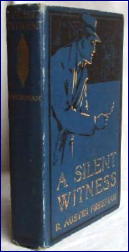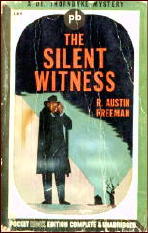Sun 13 Dec 2009

R. AUSTIN FREEMAN – A Silent Witness. Hodder & Stoughton, UK, hardcover, 1914. John C. Winston Co., US, hc, 1915. Reprinted many times since, including: Dodd Mead, hc, 1929; Pocket #184, pb, 1942.
Dr Humphrey Jardine’s narration treats of a strange chain of events that befell him when he was newly qualified, at a time when there were still horse-drawn cabs and the descent of dusk saw lamplighters at work.
His adventures began late one evening when he went for a stroll along Millfield Lane on the edge of London’s Hampstead Heath. He sees a corpse, a clerical gent going by his garments, lying further up the narrow thoroughfare but when he returns with police reinforcements a few minutes later the body has gone.

Naturally enough, the chaps in blue are politely sceptical about what Jardine saw or, as they see it, did not see.
Jardine returns next day to examine the lane and finds a suspicious stain on the fence near where the body had lain. He also picks up a tiny reliquary made of gold, its frayed silk cord suggesting it had been worn as a necklace or in some other way about its owner’s person.
Climbing up and looking over the fence, he sees obvious tracks leading away from the fence — taken all together, suggestive circumstances to say the least.
Dr Thorndyke suggests Jardine act as locum tenens for a doctor residing in Jacob Street, thus pitching the young medic into a positive whirlwind of odd goings-on, including a particularly inventive effort at murdering Jardine.
Thorndyke’s colleague Dr Jervis takes over Jardine’s position pro tem, and investigations get under way to find out who is assiduously trying to dispose of Jardine, a man with, so far as he knows, no enemies and with no relatives liable to benefit by his death.

My verdict: The plot unspools into a web of disturbing incidents, unexpected meetings and re-meetings, attempted murders, and a deserted house which nonetheless tells a great deal as the novel rattles up hill and down dale, or rather lane, in a landscape through which move a pretty young artist with a ferocious aunt, a mysterious stranger afflicted with a rare eye disorder, a Jesuit priest seeking news of a missing friend, and a “downy bird” or two of both genders — not to mention a hidden portrait.
There is much following about of various people and sending of telegrams, and, of course, despite lack of clews, Thorndyke cracks the case, although not in time to … but no, I shall say no more.
Etext: http://www.gutenberg.net.au/ebooks03/0301591.txt
December 14th, 2009 at 12:33 am
I never found Freeman and Thorndyke as “dull” as they were claimed to be. The fascination of Thorndyke’s methods and his brilliant summations provide thrills in themselves, and there is more melodrama — especially in the short stories — than is usually credited.
That said, Freeman doesn’t have the facility of phrase and the warmth of Doyle or Chesterton. Even compared to Holmes, Thorndyke is a cold fish — though he has a puckish sense of dry humor at times. Still, his summations of the case are among the best ever written.
Of course this is one of the classics of Freeman’s output, and one of the best of the novels. Whatever else, Freeman is a better detective novelist than Doyle or Chesterton, who did their best novel work in other genres (Hound of the Baskervilles is only just a novel — and a very short one at that).
Incidentally the single best buy in the mystery genre is still John Thorndyke’s Cases, an omnibus edition that contains all but two of the Thorndyke short stories. And it is also available as a free download in e-book form.